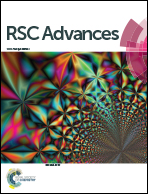The first demonstration of a novel isolated fungus Eutypella sp. BJ associated with the biodegradation of polyvinyl alcohol
Abstract
The aim of this work is to study the potential degradation of polyvinyl alcohol (PVA) by a novel fungus Eutypella sp. BJ isolated from soil compost. When it was cultured on a semi-synthetic medium containing PVA at 30 °C and 160 rpm for 8 days, the removal rates of PVA 1788, 1799 and 2488 reached 87.40%, 86.31% and 44.80%, respectively. Gel permeation chromatography (GPC) analysis revealed significant reductions of the number average molecular weight and the weight average molecular weight of PVA 1788 from 47 358 to 13 345 and from 71 387 to 24 238, respectively, after 8 days. Fourier transform infrared spectroscopy (FTIR) indicated that some substances containing carbonyl groups (likely aldehydes or ketones) might have been produced during the biodegradation process. These results indicate that the isolate has potential for degrading PVA. This study provides the first demonstration that Eutypella has the ability to assimilate PVA.



 Please wait while we load your content...
Please wait while we load your content...